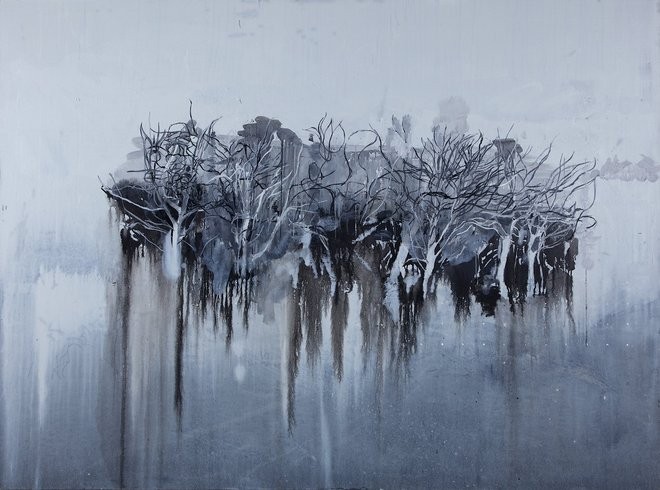Hurvin Anderson
15 Oct - 16 Nov 2013
HURVIN ANDERSON
New Works
15 October - 16 November 2013
Hurvin Anderson has composed his third exhibition at the gallery in close conjunction with his first museum survey, which opens shortly at IKON, Birmingham, his native city. Entitled 'Reporting Back', the latter spans more than fifteen years of painting, whilst the exhibition in London presents new works, on canvas and paper. The two shows create a dialogue that reveals the subtle shifts and careful evolution of his oeuvre.
A British painter of Jamaican descent, Anderson has become known for his interiors and landscapes that bear the hallmarks of his origins. Makeshift barbershops, public parks, country clubs, botanical gardens and the swimming pools of his youth are evoked in paint as lingering memories. These "sites of leisure", as he likes to call them, recur as motifs, sometimes in series, sometimes years apart, drifting like his imagination through states of 'in-between-ness', adopting the visual languages - and states of mind- of both England and the Caribbean.
The art critic Jennifer Higgie puts it more eloquently in the IKON exhibition catalogue: "In (Hurvin Anderson's) work, histories and memories intertwine; an English landscape might echo a garden in the Caribbean, and vice versa. (...) the journeys that are hinted at here are solitary, introspective ones. Yet, even in the loneliest of landscapes, someone hovers in the wings; everywhere has, to some extent, been shaped by human intervention."
Anderson's work rightly occupies a place within a rich lineage of British painting; vibrant, intuitive and atmospheric, yet rigorously structured. The artist continuously reaffirms this place, perhaps even more vividly than ever in his latest works, by emphasising the juxtaposition of motifs and networks of grills and grids to the picture plane. Something that Higgie has observed again: "In recent paintings Anderson has pushed the intermingling of abstraction, figuration and decoration to an intense new level, painting grids over scenes of lush areas of green that could be everywhere and nowhere."
There is a sense that Anderson, both in his latest body of work, and in the very precise way he has organised his new exhibition, wants to root his audience, suspend our disbelief, and slightly unsettle us all at the same time. More than ever before Anderson has set the stage in deceptive formal simplicity: intimate, intricate scenes and details of interiors at 11 Duke Street and large, lush landscapes at 3 Duke Street. This is not so much an academic division of genres, rather, a way for Anderson to use the familiar motifs and quietly reveal his ideas and struggles about private and public spheres, about cultural environment and expectations, and generally about painting.
New Works
15 October - 16 November 2013
Hurvin Anderson has composed his third exhibition at the gallery in close conjunction with his first museum survey, which opens shortly at IKON, Birmingham, his native city. Entitled 'Reporting Back', the latter spans more than fifteen years of painting, whilst the exhibition in London presents new works, on canvas and paper. The two shows create a dialogue that reveals the subtle shifts and careful evolution of his oeuvre.
A British painter of Jamaican descent, Anderson has become known for his interiors and landscapes that bear the hallmarks of his origins. Makeshift barbershops, public parks, country clubs, botanical gardens and the swimming pools of his youth are evoked in paint as lingering memories. These "sites of leisure", as he likes to call them, recur as motifs, sometimes in series, sometimes years apart, drifting like his imagination through states of 'in-between-ness', adopting the visual languages - and states of mind- of both England and the Caribbean.
The art critic Jennifer Higgie puts it more eloquently in the IKON exhibition catalogue: "In (Hurvin Anderson's) work, histories and memories intertwine; an English landscape might echo a garden in the Caribbean, and vice versa. (...) the journeys that are hinted at here are solitary, introspective ones. Yet, even in the loneliest of landscapes, someone hovers in the wings; everywhere has, to some extent, been shaped by human intervention."
Anderson's work rightly occupies a place within a rich lineage of British painting; vibrant, intuitive and atmospheric, yet rigorously structured. The artist continuously reaffirms this place, perhaps even more vividly than ever in his latest works, by emphasising the juxtaposition of motifs and networks of grills and grids to the picture plane. Something that Higgie has observed again: "In recent paintings Anderson has pushed the intermingling of abstraction, figuration and decoration to an intense new level, painting grids over scenes of lush areas of green that could be everywhere and nowhere."
There is a sense that Anderson, both in his latest body of work, and in the very precise way he has organised his new exhibition, wants to root his audience, suspend our disbelief, and slightly unsettle us all at the same time. More than ever before Anderson has set the stage in deceptive formal simplicity: intimate, intricate scenes and details of interiors at 11 Duke Street and large, lush landscapes at 3 Duke Street. This is not so much an academic division of genres, rather, a way for Anderson to use the familiar motifs and quietly reveal his ideas and struggles about private and public spheres, about cultural environment and expectations, and generally about painting.

